#Barbara Canepa
Explore tagged Tumblr posts
Text





First concept arts made in 1998. When guardians was still called Dee, Mara, Faitha, Cornelia, Mai Lin.
Concept arts by Alessandro Barbucci & Barbara Canepa
#w.i.t.c.h.#w.i.t.c.h. comics#disney#will vandom#irma lair#taranee cook#cornelia hale#hay lin#witch#concept art#1990s#art#alessandro barbucci#barbara canepa
388 notes
·
View notes
Text

Potential W.I.T.C.H. Live Action Adaptation For Disney+ In Meeting Talks With Original Creators.
Disney is looking to bringing Heatherfield and Kandrakar to the live-action realm as the House of Mouse is looking to revive the popular Italian fantasy franchise W.I.T.C.H. for a potential live-action adaptation for Disney+.
This was revealed by Trey Callaway writter of the first season of the original animated W.I.T.C.H. series from the 2000s on the podcast Radical Retro Rewind?! talking that Disney is in meetings with the creators of the W.I.T.C.H. franchise on a potential live-action adaptation of the series for the streaming service.
youtube
On October 4, 2023, a reboot graphic novel, W.I.T.C.H. - Il cuore dell'amicizia, was published in Italy by Disney Books and Disney Press.
It seems that Disney is looking to bring some of its popular cartoons from the 90s and 2000s from Disney Television Animation and Disney EMEA Animation in the live-action world as a way to compete with Netflix's huge sucessful live-action adaptations of the beloved anime "ONE PIECE" and the Nickelodeon Animation series AVATAR: THE LAST AIRBENDER who where huge hits for them with accumulating over 2B views upon release. Additionaly yesterday the rival platform ordered a new "SCOOBY DOO" live action series from Warner Bros Television.
Disney started this strategy by ordering a live-action reboot of the beloved Disney Television Animation action series from the 90s "GARGOYLES" for the Disney+ streaming service which is being executive produced by James Wan and Jason Blum through the Atomic Monster and Blumhouse Television label with Gary Dauberman acting as showrunner.
Additionaly a tween live-action sitcom based on the Disney Jr. series "VAMPIRINA" is coming to Disney Channel later this year as part of a new strategy by Disney Branded Television CEO Ayo Davis to innovate the It's A Laugh Productions division.
#W.I.T.C.H.#Disney W.I.T.C.H.#W.I.T.C.H. Reboot#W.I.T.C.H. Live Action#Elisabetta Gnone#Alessandro Barbucci#Barbara Canepa#Claire Paoletti#Andrew Nicholls#Darrell Vickers#Greg Weisman#Trey Callaway#Disney Branded Television#Disney Television Studios#Walt Disney Television Alternative#20th Television#Disney+#Disney Plus#Disney+ Originals#Disney Plus Originals#Disney+ Original Series#Disney Plus Original Series#Disney+ Original Live Action Adaptations#Disney Plus Original Live Action Adaptations#Youtube
43 notes
·
View notes
Text


Sky Doll: Sudra #1
Barbara Canepa and Alessandro Barbucci
Titan
20 notes
·
View notes
Text
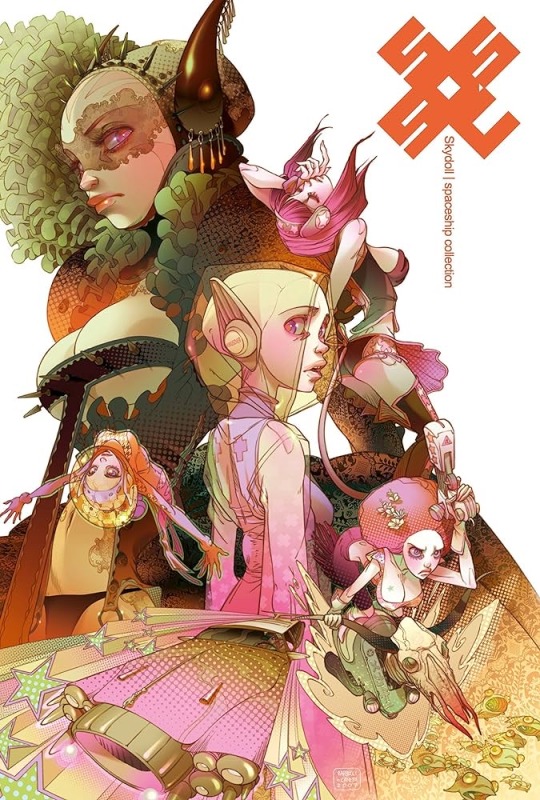

Sky Doll “Spaceship Collection” by Alessandro Barbucci and Barbara Canepa.
31 notes
·
View notes
Text
W.I.T.C.H., interview with the creators
Some time ago, I made a post about "the original Elyon being a guardian," and since everyone was confused, I thought I'd translate the interview from which I read this information.
I don't know if someone else has already done it, but since I didn't find anything online, I decided to do it myself. I will translate the entire interview with the help of an online translator and a friend of mine.
Just remember that this interview was published in April 2021, marking 20 years since the release of the first volume.
Enjoy!
Here the original link in italian: https://heroica.it/w-i-t-c-h-20-anni-barbucci-canepa-intervista/

It is April 3, 2001 when Italian newsstands are hit by a small earthquake, which will soon transform into a hurricane...
The first issue of W.I.T.C.H. is released, a comic magazine that will shatter every sales record in a matter of months, embarking on a quest to conquer the world.
It all begins in Milan, at the headquarters of Walt Disney Company Italy, with an intuition of the then-director of the company's women's periodicals, Elisabetta Gnone, and the talent of two young artists, Alessandro Barbucci and Barbara Canepa, whom I have interviewed for you.
Interview with Alessandro Barbucci and Barbara Canepa
Let's start from the origins: How was W.I.T.C.H. born?
Alessandro Barbucci: It was 1997, Sailor Moon was still fresh in everyone's memory [the last series had been broadcast in Italy between March and May of that year, editor's note]. And then there were the Spice Girls...

"Sailor Moon was ironic, arrived at the right moment; the Spice Girls were five purely pop characters, worthy of a cartoon - during that period, we were big fans, we even went to see the movie in the cinema!" Alessandro revealed to me.
Elisabetta Gnone, who was then in charge of the women's periodicals at Walt Disney Company Italy, had a great intuition: she realized that there was a missing product for teenage girls, an audience segment that had never been considered by the major company before. When thinking about teenagers, one couldn't ignore what was happening in pop culture at that moment...
Barbara Canepa: During that period, a passionate fanbase for manga was beginning to take shape. it was clear how this new language was able to respond to the tastes and needs of teenagers - not just boys, but girls as well!
In fact, up until that moment, it was believed that girls didn't read comics. It was precisely with shoujo manga (like Sailor Moon, but not only) that this belief began to falter.
Canepa: Exactly. I had already been an avid manga reader since the days of Candy Candy: we're talking about 1986 when Mondadori released the first monthly editions at newsstands. I started reading my first manga at the age of 12, and at 16, I saw Akira (1988) for the first time in theaters. In fact, I was the one who got Alessandro passionate about this style, even though he already had some knowledge of it. We felt that the language of manga was the best way to visually "tell" this story.
Barbucci: Initially, I proposed girls in a steampunk, military style. I was a big fan of Tank Girl by Hewlett and Martin.

In my mind, Hay Lin had already existed for a long time: I had been drawing her since high school, but she was a punk with military boots," Alessandro revealed to me.
Elisabetta Gnone told me that the concept was considered too "masculine," so she proposed the idea of the five witches, which directly connected us to manga. Some people at Disney Italy were afraid that, given the theme, it would veer into Satanism, but their greatest fear was the manga-style big eyes!
Canepa: For them, it was inconceivable to publish a comic even vaguely inspired by manga, which at that time were their direct competitors in the market.
Barbucci: At one point, they considered investing in the relaunch of Daisy Duck by introducing our five characters as anthropomorphic animals. It was an attempt to somehow connect with the Disney universe.
Canepa: Yes, exactly. The project was called Daisy D. and it was intended for the monthly magazine Minnie Mag. The story featured Daisy Duck as a private investigator, accompanied by our W.I.T.C.H. characters, who in this version would have had snouts and gloves, just like Minnie and Mickey! I still have the first page done in watercolors, as we wanted to make it like the pages of Paperinik's Trip...
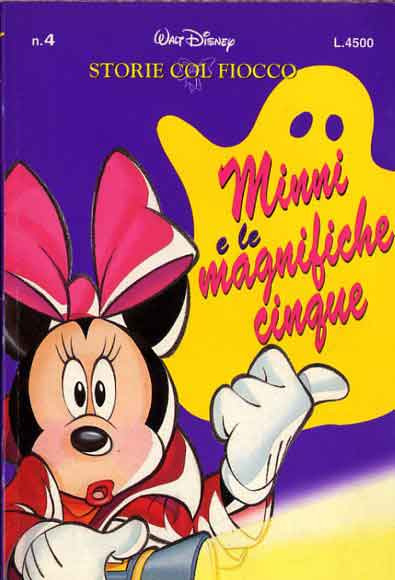
The scriptwriter, Ilaria Isaia, revealed to me that the inspiration for Daisy D. came from the success of "Minnie and the Magnificent Five," a story published in Minnie & Company in 1993. It featured Minnie in the role of an investigator, solving a mystery connected to five girls. Daisy D. wouldn't have been very different: "It revolved around Daisy Duck as an investigator, called by her friend to investigate mysterious events happening in a college attended by five students with magical powers," explains Ilaria.
Barbucci: Fortunately, nothing came of it.
Canepa: We were well aware that a story starring Daisy Duck wouldn't resonate with teenagers. We needed five normal girls that the readers could identify with...
Barbucci: So, the W.I.T.C.H. characters returned to being human.

For Will's design, Alessandro Barbucci Alessandro Barbucci was also inspired by "Alita" (1990) by Yukito Kishiro.
The graphic style of W.I.T.C.H., while drawing inspiration from manga, remains a hybrid of the West and the East. It doesn't stray too far from certain Disney characters, starting with Ariel from "The Little Mermaid" (1989).
Barbucci: I can tell a funny anecdote about this! As we mentioned, Disney Italy opposed W.I.T.C.H. in every way possible: they particularly disliked those manga-style big eyes. Together with Elisabetta Gnone, we came up with a game, a kind of bet with the top executives of Disney Italy. I drew a series of eyes, including manga characters, Disney characters, and our W.I.T.C.H. characters. Only the eyes were visible, nothing else. "Since you have so much to say about these manga eyes, guess which ones belong to the W.I.T.C.H. characters!" That was the bet: they could no longer complain. Well, they were wrong: they chose the eyes of Ariel from "The Little Mermaid" (1989), the protagonist of the Italian magazine of the same name, directed by Elisabetta herself, and successfully published by them for years. They didn't take it well...

Indeed, Ariel broke the Disney graphic conventions with the proportions of her face.
Barbucci: It was a "graphic shock," something that had never been seen in Disney until that moment. It was certainly a step towards manga aesthetics, with these very large eyes that we later found in the design of many subsequent characters, from Belle and Jasmine to Anna and Elsa.
We remember that you and Barbara worked on the magazine "The Little Mermaid" in the 1990s, just before W.I.T.C.H. started. In the covers drawn and colored by Barbara, I can already perceive some hints of manga style. Was it intentional?
Canepa: Absolutely yes! At that time, I bought Japanese magazines like Newtype and Animage to get inspiration. In one of the illustrations I made, there's Ariel with a straw hat: I think I took inspiration from an image of Nadia from "The Secret of Blue Water" (1990-91), or maybe from some other cover. The close-up of the face, as well as the fluttering leaves [like flowers in shoujo manga, editor's note], the pose of a model on the cover of a fashion magazine... it was all too innovative and "manga" for Disney Italy at that time, which often had something to say about my work! Even before W.I.T.C.H...
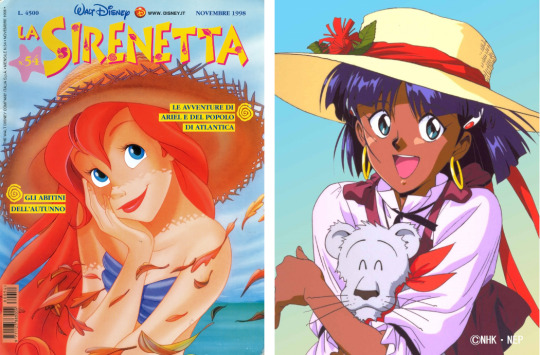
The scan on the left is taken from the website www.onlyshojo.com.
Walt Disney Company Italy didn't want anything to do with W.I.T.C.H., as we mentioned. What made them change their minds?
Barbucci: We worked on it secretly for at least a year, even at night. Then, finally, a ray of light... At the time, the main headquarters of Disney would send representatives around to other offices to find out what was being done in the rest of the world. Elisabetta was lucky to come across an American manager who was a big fan of Wicca. [Secretly from the top management, editor's note], she presented W.I.T.C.H. to him: he fell in love with it and financed the project, ordering Walt Disney Company Italy to proceed with its production.
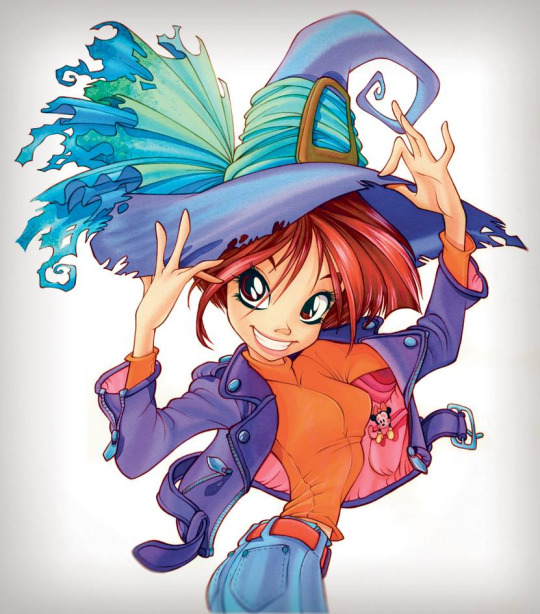

Concept art created by Barbucci and Canepa between 1998 and 1999. Notice the homage to Minnie in the first illustration!
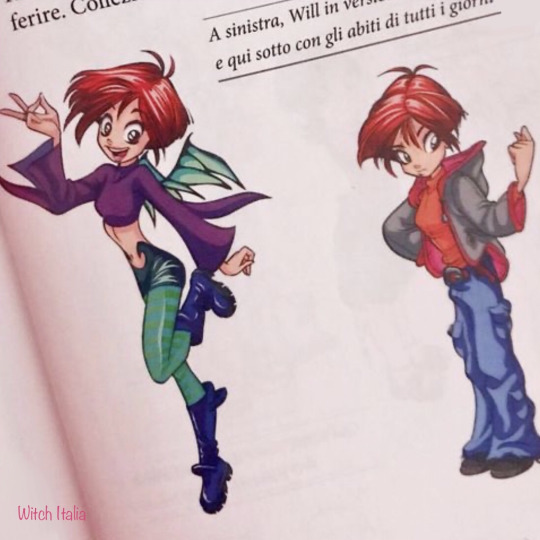

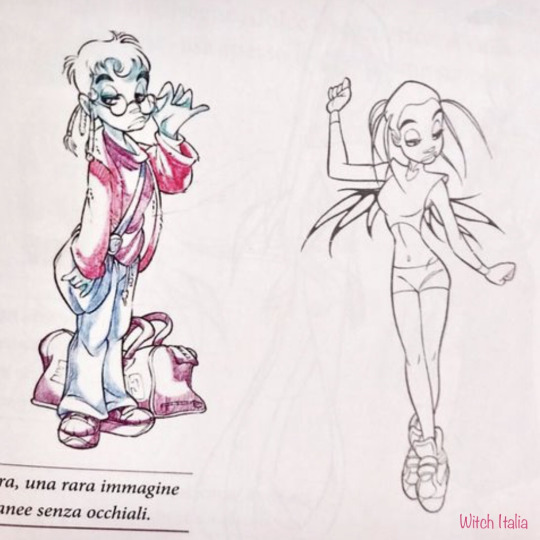

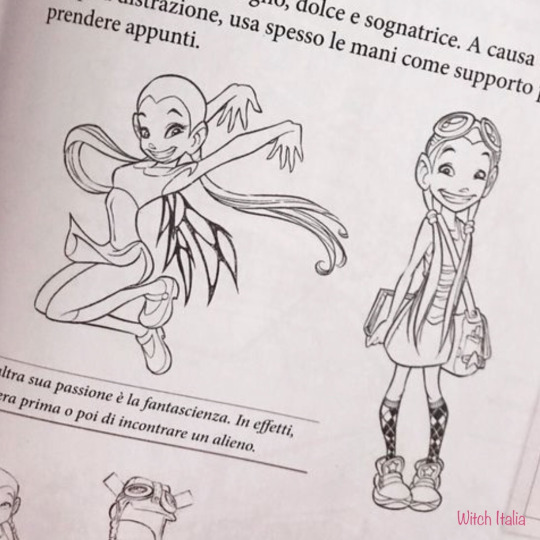
Images provided by W.I.T.C.H. Italia.
The project then gets underway. How did you divide the work?
Canepa: It's hard to say. Officially, Elisabetta wrote the plot, Alessandro created the character design, and I took care of the color and atmosphere. In reality, the three of us worked together on the concept, characters, and the world they would inhabit. We drew inspiration from our personal lives when creating these five girls. The city of the W.I.T.C.H., Heatherfield, is a mix between our hometown of Genoa and San Francisco, which we had visited together. Will shares my birthdate, while Elyon shares Alessandro's. At the time, I was a big fan of frogs, just like Will! Cornelia's cat is named Napoleon, just like mine - I also gave the same name to Elisabeth's cat, the protagonist of the first volume of END, the comic I created with Anna Merli. For Hay Lin's restaurant, we were inspired by a small Chinese "hole in the wall" where we often ate near our apartment in Milan... In short, W.I.T.C.H. was built and conceived based on our personal experiences: friends, memories from adolescence, and more.
Based on these characterizations, I created the character profiles that you can find in the first five issues of the magazine, as well as some internal editorials.
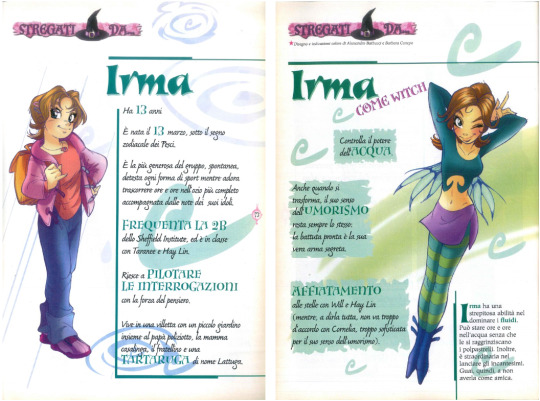
The character of Irma is inspired by Barbara Canepa in terms of design and personality, while Will is inspired by Elisabetta Gnone: with her, she shares an introverted personality and the detail of touching his hair when she is embarrassed.
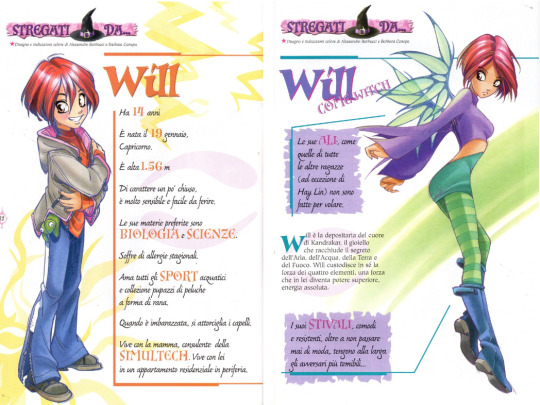
Scans by poochieandotherfriends.it
Elisabetta chose the ethnicities and names of the girls, coming up with the acronym W.I.T.C.H., while Alessandro created the symbols of the Guardians. To draw the Heart of Kandrakar, Alessandro was inspired by a pendant, a unique piece that I was very attached to and still possess to this day!
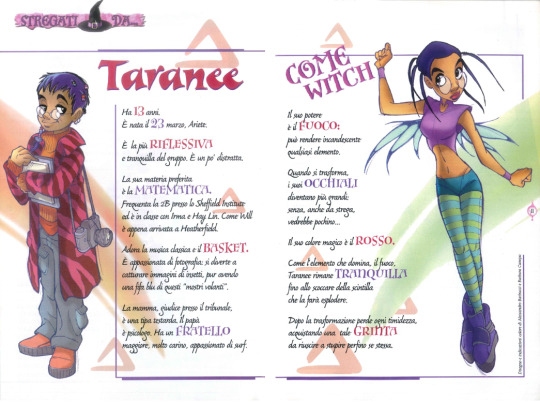
Scans by poochieandotherfriends.it
Lastly, I'll reveal something you may not know: I was the one who designed the Witch's transformed costumes! I remember when Elisabetta jokingly scolded Alessandro, telling him to draw them less provocatively... (laughs). As for their everyday costumes, Alessandro created them, often drawing inspiration from his and our friends.

Scans by poochieandotherfriends.it
Another significant responsibility of ours was to form a team of artists who would work on W.I.T.C.H. alongside us. In fact, Alessandro and I couldn't have done it all by ourselves: W.I.T.C.H. was becoming a massive and important project, especially since it would be released on a monthly basis! Therefore, we conducted courses at the Disney Academy: Alessandro taught how to draw the Witch, while I taught manga techniques, coloring, and graphic design.

Scans by poochieandotherfriends.it
Did you encounter any other issues with Disney Italy during the production?
Canepa: There were some controversies, but at that point, the project was already underway. There were several delays, actually: the first issue was supposed to be released on Halloween in 2000. I remember that they criticized the covers: they didn't like the white background, and in the first cover, they didn't like the difference in proportions between Will and the others, which is another typical graphic characteristic of manga.
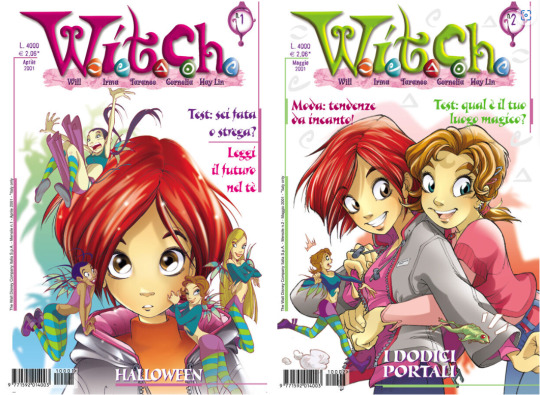
Barbucci and Canepa created the first five covers of W.I.T.C.H. and the corresponding chapter opening pin-ups.
You create the comic of the first issue: On the third page, there's a very intense panel with Will partially nude (without nipples); she appears like that later during the Sailor Moon-style transformation as well. These are not erotic images, but they certainly deviate from the Disney style. Did you face any issues regarding this?
Barbucci: Strangely, no. Maybe they had already given up at that point...

Scans by poochieandotherfriends.it
You left the project after the sixth issue. What happened?
Barbucci: The back and forth with Disney to bring W.I.T.C.H. to newsstands was incredibly exhausting. By the year 2000, we were drained from the continuous meetings, discussions, and delays... Moreover, both Elisabetta and we had realized our potential as authors. She was the first to leave: she left the world of magazines to fulfill her dream of becoming a novelist. And she succeeded greatly, as a few years later, she created the Fairy Oak series of novels, which sold millions of copies worldwide! Barbara and I were already in contact with various French and American publishers. In France, they allowed us to express ourselves artistically in a completely free way. It felt like a dream! There were so many things we wanted to talk about, things that weren't even proposable in Disney: sex, religion, politics... Sky Doll was born during this period. Furthermore, there were legal disagreements with Disney regarding the moral rights of the Witch characters. In short, after a few years with the multinational company, it was time for us to move on to other things. We needed a change of scenery!
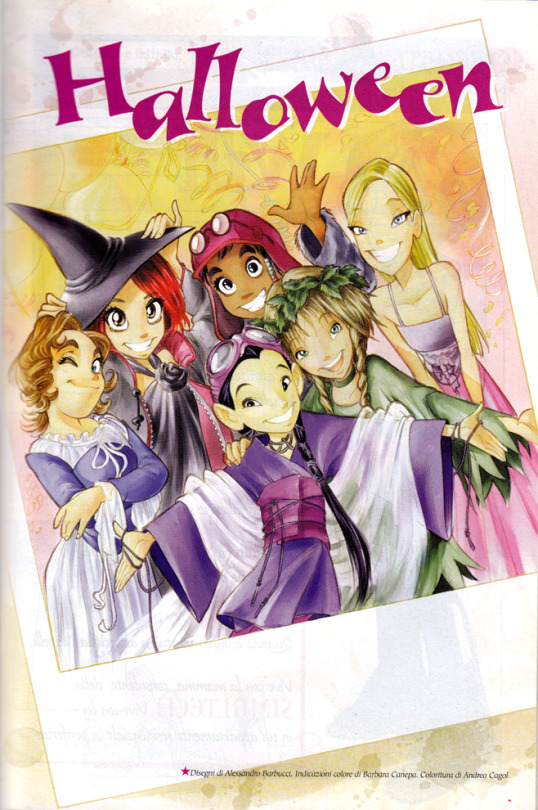
The story you had in mind for W.I.T.C.H. was different from what we later read in the issues after your departure?
Canepa: Yes, it was darker, introspective, and more complex. It was a glimpse into teenage life presented through five very different girls. The plot had different layers of interpretation, including ecological aspects. It was certainly closer to manga in terms of themes: there was more focus on the girls' personal lives, their adolescent struggles. There wasn't a clear division between good and evil: the girls would be drawn to the Metaworld and tempted to join, crossing over to the other side of the barricade. Elyon would be the first to succumb, but they would all do so to some extent, even fighting against themselves.
Moreover, the Metaworld was a fascinating place, a natural paradise that was quite different from the medieval setting that Disney eventually created. At the heart of it all was the concept of growth and transformation, which is so dear to adolescence: the girls would have had the ability to transform into fantastic animals! Like teenagers who find themselves caught between childhood and adulthood, the W.i.t.c.h. would have been caught between two worlds, remaining trapped in one or the other, by choice or against their will. It wasn't always clear...

The W.I.T.C.H. transform into adult versions of themselves, adhering to the main theme of many majokko ("magical girl") anime.
Even Elyon, who in the version you have read is the princess of Meridian, was a very different character in our story. She was the Guardian of the Metaworld and had powers related to time, wild nature, and death. She would have tried to bring the other girls to the dark side and then redeem herself: in the last issue, she would have sacrificed herself to save the lives of her friends.
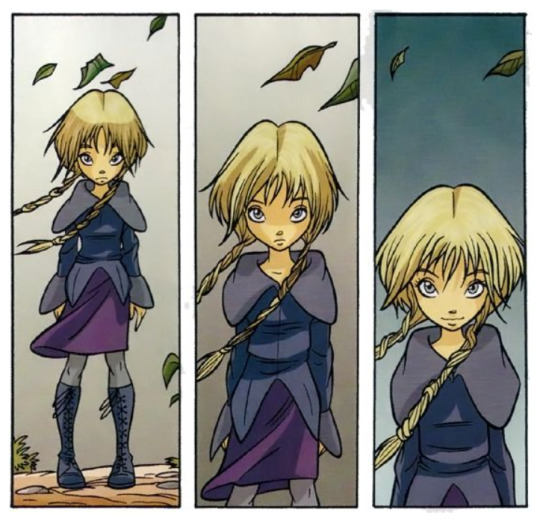
In W.I.T.C.H. #2, you can perceive some traces of the original Elyon, who at a certain point addresses the girls repeating, "Come to me, come to me..." as if trying to lead them to the dark side.
I transferred her main power, the ability to "bestow" death, to the protagonist of END, Elizabeth: with this character, I have done and will do everything that I couldn't do with Elyon, who was initially supposed to have white hair like her.

Barbucci: What was actually realized was a harmless mythology, closer to fairy tales and therefore to the Disney style. There is no mention of witches anymore... We would have focused on a more New Age aesthetic, with references to Wicca, which was very popular in those years.
After leaving W.I.T.C.H., you left Italy for France, from where you embarked on various successful projects, with Sky Doll first. It can be said that you found your dimension and creative freedom. Now that 20 years have passed, what is your relationship with W.I.T.C.H.?
Canepa: It's needless to say that the bond has always been very strong and still is today. It was our own creation for a long time: seeing it succeed worldwide brought joy, but also suffering because we felt disconnected from it.
Barbucci: It was a love-hate relationship, but I must say that it gave me the greatest satisfaction of my life: seeing dolls of the characters I drew being sold in supermarkets!

Some sketches made by Alessandro Barbucci at the beginning of 2021, to celebrate the twentieth anniversary of W.I.T.C.H.
Canepa: After twenty years, perhaps it can be said that we have made "peace" with what happened. The hardships we endured have now drifted away with the wind, and that's how it should be. Today, I can talk about W.I.T.C.H. with more tranquility, almost with tenderness. For many years, I didn't even want to face it. Initially, leaving Italy helped, but then W.I.T.C.H. reached France and the rest of the world. Over time, this forced me to look at it with more "serene" eyes, so to speak. If I hadn't left W.I.T.C.H., I would never have created Sky Doll and END, and perhaps I would have never become the director of a French series that, today, celebrates nearly 100 books 12 years after its creation. Destiny, then? I believe so. Fate wanted to take something away from me to give me something else. In hindsight, I truly believe there was a magical thread in all of this... or rather, a true witch's touch! There is a happy ending to it all: today, history reminds us that we are the true creators of W.I.T.C.H. The readers know it, and so do industry professionals. Even Disney, in the end, acknowledged us. Every now and then, Elisabetta, Alessandro, and I talk and, laughing, we say, "What if we got back together and remade W.I.T.C.H. in our own way?" In any case, this remains and will always be the most important project of my life. And to have touched so many hearts around the world... well, there's nothing more beautiful and satisfying. So, thank you all. I was happy to give you these five girls.
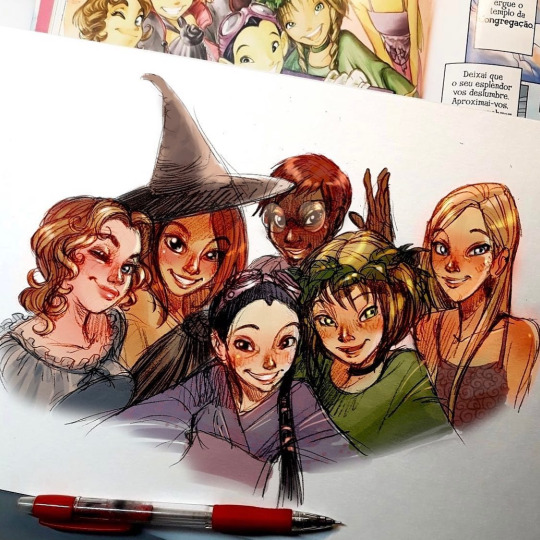
For Women's Day 2021, Barbucci drew again the famous pinup from the first issue, Halloween.
Current and Future Projects
Alessandro Barbucci His most recent work is "Le Sorelle Grémillet" where he returns to portraying teenage girls ("it's a bit like how I would have liked to create W.I.T.C.H. back then, but it wasn't possible"). Additionally, Alessandro continues to work on "EKHÖ" and other projects. Follow his Instagram and Facebook to stay updated!
Barbara Canepa For over 12 years, Barbara Canepa has been the editorial director of the Metamorphose series for the French publisher Group Delcourt, with over 100 published books. She has several projects in the works, including "MINA's Diary," where she will serve as the writer, while Isabella Mazzanti will handle the artwork and coloring. The work is a free interpretation of Stoker's Dracula, introducing a new way of conceiving vampires. For the past two years, she has been finishing the writing of 12 volumes of a new jeunesse series, "GREENWOOD," aimed at rediscovering and respecting nature to the fullest. Stay updated on her activities by following her on Instagram and Facebook!
#w.i.t.c.h.#interview#alessandro barbucci#barbara canepa#disney#witch#elyon escanor#will vandom#irma lair#taranee cook#cornelia hale#hay lin#end
74 notes
·
View notes
Text
If I had a nickel for every couple of Disney comic book authors who left Disney to find success thanks to a graphic novel series centered around p̶r̶o̶s̶t̶i̶t̶u̶t̶i̶o̶n̶, I would have 2 nickels. Which isn't much, but it's weird it happened twice.
And they ended up eventually under the same publisher too.
#comics#disney#alessandro barbucci#barbara canepa#sky doll#teresa radice#stefano turconi#il porto proibito#le ragazze del pillar#bao publishing#disney comics
6 notes
·
View notes
Photo
Teenage love of mine . . .
Sky Doll . . . comic book by Barbucci and Canepa

106 notes
·
View notes
Text
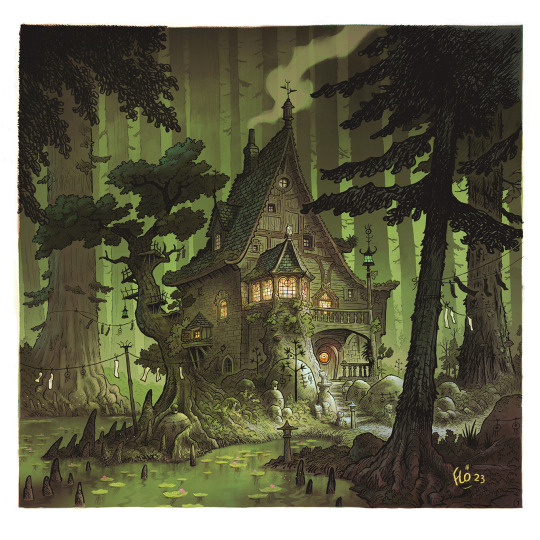
Au chant des grenouilles T1 (scénario Barbara Canepa et Anaïs Halard).
#conte#fairytales#fairytale#illustration#fantasyart#fantasyartwork#florentsacre#bandedessinee#comics#nature#inkart#colors#graphicnovel#bdjeunesse#witch#witchcraft#childrenbook
5K notes
·
View notes
Text
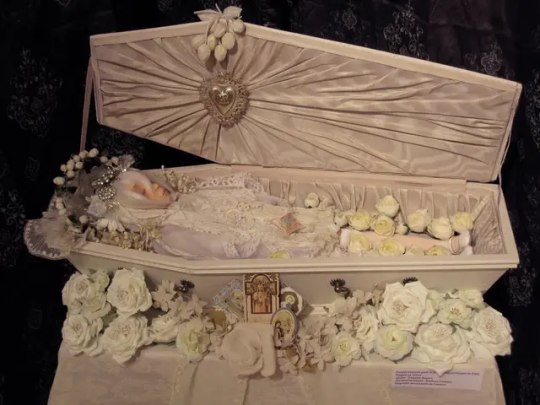
By Virginie Ropars - after Barbara Canepa and Anna Merli's graphic novel End
#Alright#since she is still circulating on tumblr#It's time we have her in high res and with the actual source#doll#art doll#End is one of my fav graphic novel#Also I was just going to add the source on the other post from we heart it#but the photo is quite low res#so new better post it is#enjoy the dead Elisabeth doll#according to Canepa most of the flowers and fabrics are from the Victorian era#Canepa also has a customized Unoa Doll of Elisabeth
111 notes
·
View notes
Text



1999 color treatments for W.I.T.C.H., shared by Elisabetta Gnone (artwork by Alessandro Barbucci, colors by Barbara Canepa)
53 notes
·
View notes
Note
what are some of your favorite characters design wise?
Ever? I like the works of Hidari on Fire Emblem, Tim Burton’s designs for the characters in Alice, Kimihiko Fujisaka’s for Drakengard, and Akihiko Yoshida in everything ever, and Barbara Canepa’s END, off the top of my head.
9 notes
·
View notes
Text



Promotional images from the first issues of the magazine.
#w.i.t.c.h.#w.i.t.c.h. comics#disney#will vandom#irma lair#taranee cook#cornelia hale#hay lin#witch#barbara canepa#elisabetta gnone#alessandro barbucci
53 notes
·
View notes
Text

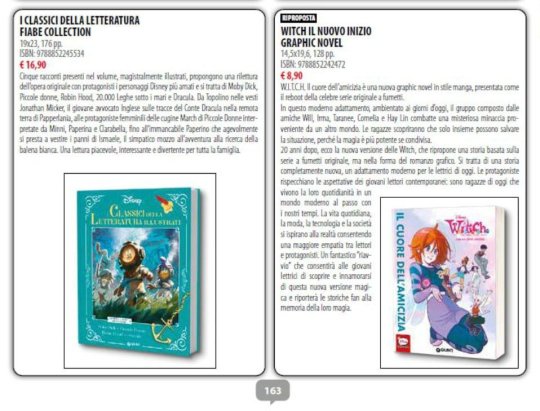
W.I.T.C.H. Sets Reboot With New Graphic Novel By Giunti, Disney Books and Disney Comics
Before Luz Noceda and The Boiling Isles with their witches world..... there where some W.I.T.C.H.
Disney Italy has announced a W.I.T.C.H. reboot as a graphic novel for Italy by GIUNTI,Disney Comics and Disney Publishing, the new graphic novel slated for October 4th, 2023 will re-introduce the beloved franchise to a new generation of kids.
📚 W.I.T.C.H IL NOVO INIZIO
October 4th, 2023
GIUNTI
Disney Comics
Disney Publishing Worldwide
W.I.TC.H. The heart of friendship is a new manga-style graphic novel, presented as the reboot of the famous original comic series In this modern adaptation, set in the present day, the group of friends Will, Irma, Taranee, Comelia and Hay Lin fight a mysterious threat from another world. The girls will discover that only together can they save the day, because magic is most powerful when shared. 20 years later, here is the new version of the Witches, which remakes a story based on the original comic series, but in the form of the graphic novel. This is a completely new story, a modern adaptation for today's female readers. The protagonists reflect the expectations of young contemporary readers: they are today's girls who live their daily lives in a modern world in step with our times. Daily life, fashion, technology and society are inspired by reality allowing for greater empathy between readers and protagonists. A fantastic "reboot" that will allow young readers to discover and fall in love with this new magical version and will bring the historic fans back to THE HEART OF FRIENDSHIP memory of their magic.
The original comics spawned a franchise with a variety of printed media, including both reprinted and original content, as well as audiovisual media. The first two arcs (The Twelve Portals and Nerissa's Revenge) were loosely adapted into an animated series by Jetix Animation Europe (Now named Disney Europe Animation) for Jetix and Disney Channel.
#W.I.T.C.H.#Disney W.I.T.C.H.#Elisabetta Gnone#Alessandro Barbucci#Barbara Canepa#Disney Comics#Disney Italy#Disney Publishing Worldwide#GIUNTI
166 notes
·
View notes
Text

Sky Doll
by Barbara Canepa and Alessandro Barbucci
10 notes
·
View notes
Text
Pages from Il Libro Perduto di Monster Allergy (The Lost Book of Monster Allergy) taken from the Amazon listing.






The book releases September 20th!
13 notes
·
View notes
Text
Today's eBay spotlight (Seller ID: RadioIndy)! W.I.T.C.H. promo comic from 2004! Given away at SDCC 2004, featuring art by Barbara Canepa from Disney Comics! #comics #witch #barbaracanepa #disneycomics #VintageComics #2004 #sdcc #ComicCollector #comicdealer #auctions #ebay #RadioIndy #DownsizingMyCollection #EverythingMustGo #BuyMyStuff
instagram
2 notes
·
View notes